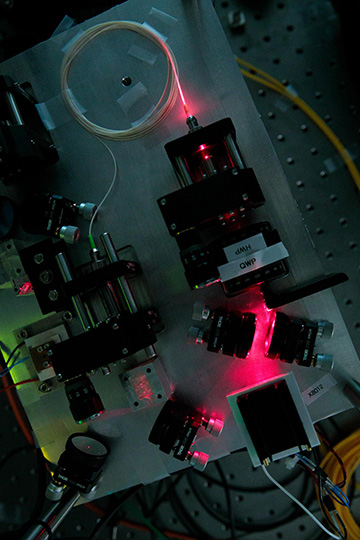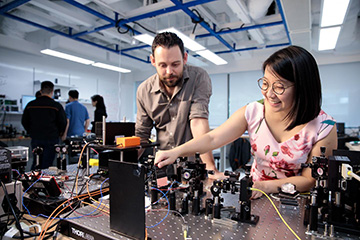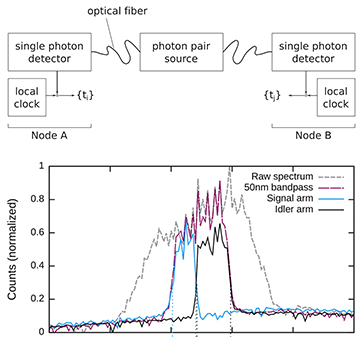
Bench setup at NUS-Singtel Cyber Security R&D lab for generating entangled photons. [Image: National University of Singapore]
Quantum key distribution (QKD), both satellite based and in optical-fiber communications, constitutes a core technology for securing the information networks of the future. But in fiber networks, dispersion—the prism-like smearing-out of frequencies and arrival times as broadband light propagates through the fiber—can play havoc with the delicate timing correlations between entangled photon pairs that such quantum encryption requires.
Now, researchers at the National University of Singapore (NUS) have tested out a neat trick for avoiding dispersion effects in fiber-based QKD, without adding dispersion-compensating equipment or making other changes to the installed fiber network (Appl. Phys. Lett., doi: 10.1063/1.5088830). The secret lies in engineering the wavelength and spectral characteristics of the entangled photons themselves, so that they lie near the so-called zero-dispersion wavelength of single-mode fiber, around 1310 nm.
Tweaking the photon source in this way, the team showed, can preserve the timing correlations between the entangled pairs across fiber spans ranging from 10 to 80 km—even in realistic, multi-segment fiber runs with varying dispersion characteristics. The technique, the researchers believe, could make implementing quantum encryption an easier proposition in metropolitan fiber networks with substantial installed infrastructure.
Timing-based errors
In entanglement-based QKD, pairs of photons with entangled or correlated quantum states, forming the quantum “key,” are sent to both parties in the communication, and the quantum correlation is confirmed through a third (classical) communication channel. If a third party eavesdrops along the way, the entanglement is destroyed, and the eavesdropper’s presence is revealed. (See “Satellite-Based QKD,” OPN, February 2018.) For the system to work, precise timing is essential; otherwise, identifying entangled photon pairs at the two ends of the communication chain becomes a much messier, more error-prone proposition.
For this reason, chromatic dispersion in the optical fibers carrying entangled photons can be a particular headache. A key process for making entangled photons, so-called spontaneous parametric down-conversion (SPDC), is inherently broadband, creating photons across a range of different wavelengths. Dispersion in the fiber results in different travel times for different photon wavelengths, making it harder to keep those entangled photons straight as they propagate through different fiber runs. One way to overcome this is to spectrally filter the photon-pair source—but this reduces the throughput of the communications system.
The zero-dispersion trick

Team leader James Grieve of NUS (left), with colleague Amelia Tan of Trustwave, the cyber-security subsidiary of Singapore Telecommunications (Singtel). [Image: National University of Singapore]
An alternative to spectral filtering could lie in engineering the characteristics of the photon pairs at their creation so that they “self-compensate” for the fiber’s dispersive characteristics. In particular, single-mode optical fibers are characterized by a zero-dispersion wavelength—an optical wavelength where the positive or negative dispersive effects attributable to the material and to the fiber’s waveguide nature cancel each other out. Some two decades ago, it was shown that, by using a tunable SPDC photon source to create pulses with a center wavelength near the magic zero-dispersion number, the dispersive effects of fiber could be compensated for in entangled photons across fiber lengths of 9.3 km, boosting the signal-to-noise ratio of the quantum-encryption channel.
The problem is that those early experiments used a uniform, single length of fiber, with known dispersion characteristics. Practical, real-world networks consist of numerous segments of different fiber yoked together. And, while the zero-dispersion wavelength of a given segment of single-mode fiber will tend to hover somewhere around the 1310-nm industry standard, there’s considerable variation across different fiber segments.
A multi-segment test
The Singapore team, led by OSA member James Grieve, wanted to see if leveraging the zero-dispersion wavelength for QKD could work in the kind of multi-segment fiber that’s common in actual field installations. To do so, the researchers started with an SPDC source that created photon pairs degenerate at 1316 nm, close to the 1310-nm zero-dispersion wavelength standard for single-mode optical fiber, and with a broad enough emission to span a comfortable area on either side of that wavelength.

Top: Experimental setup for the work. Bottom: The SPDC source created signal and idler photons on either side of the 1316-nm zero-dispersion wavelength threshold. The dispersion characteristics of the photons in the fiber canceled each other out, reducing timing uncertainties for QKD. [Image: J.A. Grieve et al., Appl. Phys. Lett., doi: 10.1063/1.5088830; CC BY 4.0]
Wavelength-division multiplexing was used to separate signal photons, with a center wavelength slightly below the 1316-nm threshold, from idler photons, with a center wavelength slightly above that threshold. The signal and idler photons were then sent through separate lengths of multi-segment single-mode fiber and were detected and time-stamped using separate InGaAs avalanche photodiodes.
Preserving timing across an 80-km fiber length
In principle, by engineering the entangled photons in this way, so near the zero-dispersion wavelength, the signal photon should experience negative dispersion and the idler photon should experience positive dispersion. In terms of travel time, the effects should cancel each other out, allowing the photon arrival times to be matched at the photodiodes. The team found that, to first order, that’s exactly what happened—both in an 80-km length of multi-segment fiber ginned up in the lab, and in a 10-km segment of actual field-deployed multi-segment telecom fiber, owned by Singapore Telecommunications (Singtel).
The team concludes that its tests establish that “photon pairs with appropriately engineered spectral properties can experience self-compensation of dispersion in conventional telecommunication fiber networks”—despite the fact that those networks include multiple fiber segments with varying dispersion characteristics. The team believes that the result “paves the way” for increased use of QKD in such networks, without special dispersion-compensating apparatus.
There is one significant caveat, however. Doing QKD around the zero-dispersion wavelength requires that the system operate in the so-called O-band, near 1310 nm. That’s a wavelength region known to feature higher attenuation losses in fiber than the C-band, near 1550 nm, that’s standard in fiber telecommunications. But the team believes that the trade-off between attenuation and dispersion should be acceptable for boosting the viability of quantum encryption in metropolitan networks with substantial installed fiber.
